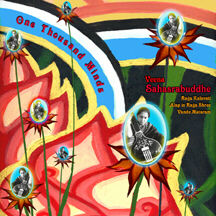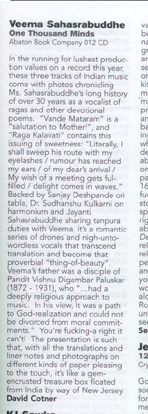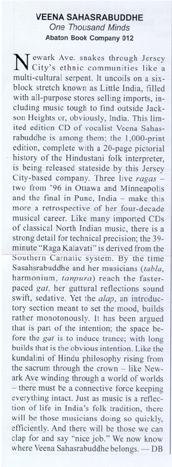Veena Sahasrabuddhe |


Postage paid worldwide.
For wholesale inquires for One Thousand Minds, please contact one of our fine distributors .
Reviews:

Signal to Noise, Winter 2006, page 95, by David Cother

Singout!, Spring 2006, Vol. 50 #1, page 125 by D.B.
From ~ Foxy Digitalis
A completely gorgeous package introducing the Hindustani music of Veena Sahasrabuddhe to America (although she has many other records on HMV, BMG-Crescendo, and Sony). Sahasrabuddhe is a north Indian performer who draws on the tradition of Pandit Vishnu Digambar Paluskar in fashioning bhajans, long, devotional pieces – but where Paluskar’s vision was solely religious, Sahasrabuddhe’s music is more generally spiritual, expressing devotion to lovers and, on “Vande Mataram,” the earth itself. On “Raga Kalavati,” recorded at Ottawa Community Hall in 1996, Sahasrabudde keeningly sings of anticipating a lover’s return, as the harmonium drones sympathetically behind her; she wails softly and subtly through most of the piece, but she saves the most fantastic ululations for the end, when the lover’s return is realized. “Alap in Raga Shree” is more disquieting, with Sahasrabuddhe moaning sorrowfully over an unrecognizeable chord, beginning as a B-flat but soon splintering into several different harmonics. No lyrics are given, so it is unclear whether the piece has an explicitly spiritual aspect, but Sahasrabudde is clearly lost in the music as any great devotional singer would be. “Vande Mataram” is a much shorter piece, but no less mesmerizing, as Sahasrabuddhe’s voice swoops over the harmonium’s buzzing tone. This is a compelling listen for anyone interested in Indian classical music, but it would also serve as a great initiation to the form.- Sal Addays
A year and nine days after the tricolor fluttered for the first time in independent India, Pandit Shankar Shripad Bodas, one of the country's finest singers became father to a girl, whom he named Veena. That girl, who would take on the name Veena Sahasrabuddhe, would go on to be one of India's most illustrious classical singers. In her 40 years as a trained khayal singer, Sahasrabuddhe has notched up many firsts, of which this album counts as a significant milestone. While her first album was released in India in 1987, this one from Abaton Book Company in New Jersey is her first American release. Though the producers have dabbed patriotism over this one by including Vande Mataram as the closing track, the other two compositions, in Raag Kalavati and a 17-minute-long alaap in Raag Shree amply demonstrate Sahasrabuddhe's understanding of material and her scholarly pursuit of music. Raag Kalavati, like many raags in the North Indian system of classical music is adapted from South Indian classical traditions and in her interpretation of the raag, Sahasrabuddhe lays out the initial three segments of the components - the alaap, jhor and jhala, before she begins the final part of her performance: the gat. Unhurried, fluent and often spiritual, Sahasrabuddhe's performance is incredible.
- Review by JAIDEEP V.G.
From ~ Rave Magazine India
|
| Abaton Archive |
Books |
Lauri Bortz |
CD, Tape & Vinyl |
Clothing |
Contact
| Cosmetics |
| Mark Dagley | Devorah Day | Distribution | Diversions | Elixirs | Abaton Garage | Home Decor | | Implements | Jewelry | Mascots | Marianne Nowottny | Shell | Videos | Julia Vorontsova | | Recent & upcoming editions | Copyright © 1997-2010 Abaton Book Company. All rights reserved. |